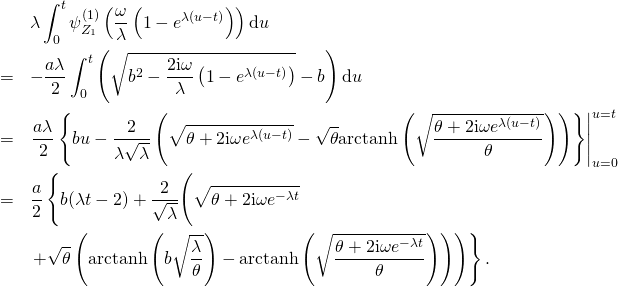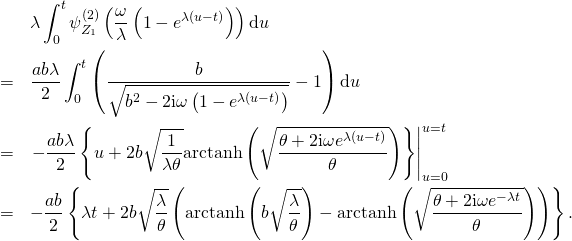In this pose, we consider an Ornstein-Uhlenbeck stochastic clock whose instantaneous rate of activity process has an inverse Gaussian stationary distribution. We use the previously obtained relationship between the cumulant generation function of the stationary distribution and that of the background driving Lévy process and show that the latter can be represented as the sum of an inverse Gaussian processes and a compound Poisson process with chi-squared distributed increments.
Related Posts
- General Stochastic Clocks
- Ornstein-Uhlenbeck Stochastic Clocks
- Gamma Ornstein-Uhlenbeck Stochastic Clocks
- Cox-Ingersoll-Ross Stochastic Clocks
Construction via the Background Driving Lévy Process
We assume that the stationary distribution of ![]() is inverse Gaussian
is inverse Gaussian ![]() with characteristic exponent
with characteristic exponent
![]()
This is the distribution of the first hitting time of a drifted Brownian motion ![]() to the level
to the level ![]() , where
, where ![]() ; see e.g. Schoutens (2003). As shown in a previous post, the following relationship holds
; see e.g. Schoutens (2003). As shown in a previous post, the following relationship holds
![]()
Thus,
![]()
As shown by Barndorff-Nielsen (1998) we can decompose the background driving Lévy process as ![]() where
where ![]() and
and
![Rendered by QuickLaTeX.com \[ Z_t^{(2)} = \frac{1}{b^2} \sum_{n = 1}^{N_t} X_i. \]](http://www.matthiasthul.com/wordpress/wp-content/ql-cache/quicklatex.com-5a24c23f04691163012d64c9da957ac4_l3.png)
Here ![]() is a Poisson process with arrival rate
is a Poisson process with arrival rate ![]() and
and ![]() is a sequence of independent identically distributed (i.i.d.) chi-squared
is a sequence of independent identically distributed (i.i.d.) chi-squared ![]() random variables with degree of freedom one; see also Schoutens (2003). We have
random variables with degree of freedom one; see also Schoutens (2003). We have
![]()
Next,
![]()
and thus
![]()
Here, we used the general form of the characteristic function for compound Poisson processes. Summing the cumulant generating functions yields
![]()
as claimed.
Integrated Time-Change
We again start from the previously obtained general solution for the characteristic function of the total activity process ![]() ,
,
![]()
We evaluate the two integrals corresponding to ![]() and
and ![]() separately. The first one is
separately. The first one is

Here, we defined
![]()
The second one is

Combining these two expressions and grouping terms yields

This expression coincides with the one given in Schoutens (2003), who defines
![]()
instead.
References
Barndorff-Nielsen, Ole E. (1998) “Processes of Normal Inverse Gaussian Type”, Finance and Stochastics, Vol. 2, No. 1, pp. 41-68
Schotens, Wim (2003) Lévy Processes in Finance: John Wiley & Sons
